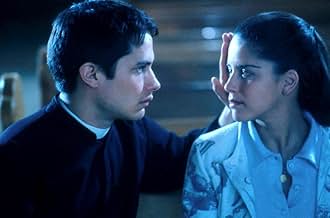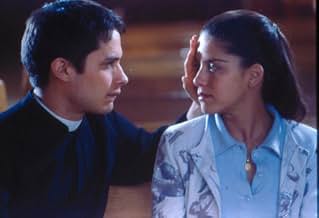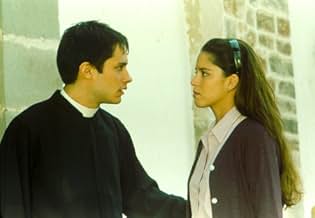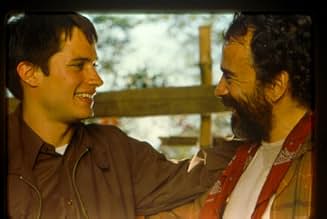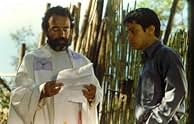IMDb RATING
6.7/10
15K
YOUR RATING
Politics and sexual passions threaten to corrupt a young, newly-ordained priest in a small Mexican town.Politics and sexual passions threaten to corrupt a young, newly-ordained priest in a small Mexican town.Politics and sexual passions threaten to corrupt a young, newly-ordained priest in a small Mexican town.
- Director
- Writers
- Stars
- Nominated for 1 Oscar
- 21 wins & 15 nominations total
Pedro Armendáriz Jr.
- Presidente Municipal Gordo
- (as Pedro Armendáriz)
- Director
- Writers
- All cast & crew
- Production, box office & more at IMDbPro
Featured reviews
This "modern" adaptation from the classic novel written by Portuguese writer Eça de Queiroz in 1875 is very disappointing. The daring and exquisite novel was turned into a Mexican melodrama. Gael García Bernal ("Amores Perros", "Y Tu Mamá También", "La Mala Educación", "The Motorcycle Diaries") is a talented actor, but even his charisma couldn't conceal the flaws of the movie.
Eça de Queiroz is a very esteemed writer at Brazilian schools, and his importance for Portuguese Literature is incontestable; he deserved more respect. I just can't understand why this "El Crimen del Padre Amaro" was so praised by most critics. Anyway, it's sad to see that such a strong book was so poorly adapted. It isn't horrible, but could have been too much better. 4 out of 10.
"One of the most controversial films ever made"? NO WAY!
Eça de Queiroz is a very esteemed writer at Brazilian schools, and his importance for Portuguese Literature is incontestable; he deserved more respect. I just can't understand why this "El Crimen del Padre Amaro" was so praised by most critics. Anyway, it's sad to see that such a strong book was so poorly adapted. It isn't horrible, but could have been too much better. 4 out of 10.
"One of the most controversial films ever made"? NO WAY!
From a novel by the 19th century Portuguese well-known novelist Eça de Queirós, the Mexican director Carlos Carrera made this good movie in which to the main ingredients present at all times everywhere (lust, the temptations of the flesh haunting Catholic priests, religious hypocrisy, love and bourgeois prejudices) he added specific Mexican ones of our times such as the fight for independent journalism, drug traffic, complicity of authorities and the fight of the peasants for dignity, freedom and a better life. He was very successful in telling the same story contained in the Portuguese novel, transposing it from the atmosphere of a Portuguese provincial town in the second half of 19th century to rural Mexico of present times. The acting of all performers is sober and efficient with special prominence to Ana Claudia in the role of the sensual nymphet who seduces the young priest not with great difficulty it must be said.
Crimen del Padre Amaro
The film Crimen del Padre Amaro is set in Los Reyes, Mexico in 2002. In Mexico by 2002, a continuing economic, political, and social crisis was spiraling deeper and deeper. The chaos was caused by a debt problem and the system of dependent capitalism the debt produced. "Between 1994 and 2000 average wages declined 21 percent" (Keen 317). By 2002, Mexico had become more and more dependent primarily upon the United States, its foreign export, and its investment-capital markets. Despite these setbacks, Mexicans always had something to fall back upon and to look to for support: the Catholic Church.
The Catholic Church is the main focus in the movie Crimen del Padre Amaro. There are no specific events that occurred within the movie that occurred in real Mexican history; however the events that do occur are believable and likely happened. Within the film, Padre Benito is taking money donations from a local drug lord to help fund a new hospital. Since there are many drug lords in Mexico it is not unbelievable that two of the most powerful groups in Mexico are the drug lords and the Church officials. It makes sense that they would overlap at some point, however I am sure that this scenario does not occur in all areas of Mexico. The director could have made it a little clearer that the drug lord was an actual drug lord; it was a little confusing with the mayor and the drug lord to keep each person separate. Another point of corruption within the Church is the fact that both Padre Benito and Padre Amaro have sexual relations with females despite their celibacy vows. This is not surprising at all, since it has become public knowledge that many Catholic priests have had sexual relations with people in recent years. The director could have shown more of the economic crisis and guerrilla warfare situations more, because they were a little confusing if one did not know or look into what was going on in Mexico in 2002.
The film is well made and attention-grabbing. The plot is a little confusing at first, as most movies are, however it all becomes much clearer and focused as the movie continues. In the beginning of the movie, Padre Amaro is seen as the good guy, who everyone wanted to succeed; however, by the end of the film, I looked upon Padre Amaro with complete disgust. Ironically, Padre Benito, I felt, was a horrible, corrupt priest in the beginning, and by the end I liked him much more than ever before. Padre Amaro was so young and yet he ended up being the most selfish and corrupt of all the priests in the community. Crimen del Padre Amaro is a very interesting film that is entertaining and worth watching to see what modern-day rural Mexico is like.
The film Crimen del Padre Amaro shows an interesting outlook of the Catholic Church and the corruption that exists within the Church in Mexico. It is very gripping and definitely worth watching. Although there are parts that can be confusing, it is fascinating to see how rural and "backward" parts of Mexican life can be. I would recommend viewing this movie and on a scale of 1-10, I would give it a 7.
Works Cited: Keen, Benjamin and Keith Haynes: A History of Latin America. New York: Houghton Mifflin Company, 2004.
The film Crimen del Padre Amaro is set in Los Reyes, Mexico in 2002. In Mexico by 2002, a continuing economic, political, and social crisis was spiraling deeper and deeper. The chaos was caused by a debt problem and the system of dependent capitalism the debt produced. "Between 1994 and 2000 average wages declined 21 percent" (Keen 317). By 2002, Mexico had become more and more dependent primarily upon the United States, its foreign export, and its investment-capital markets. Despite these setbacks, Mexicans always had something to fall back upon and to look to for support: the Catholic Church.
The Catholic Church is the main focus in the movie Crimen del Padre Amaro. There are no specific events that occurred within the movie that occurred in real Mexican history; however the events that do occur are believable and likely happened. Within the film, Padre Benito is taking money donations from a local drug lord to help fund a new hospital. Since there are many drug lords in Mexico it is not unbelievable that two of the most powerful groups in Mexico are the drug lords and the Church officials. It makes sense that they would overlap at some point, however I am sure that this scenario does not occur in all areas of Mexico. The director could have made it a little clearer that the drug lord was an actual drug lord; it was a little confusing with the mayor and the drug lord to keep each person separate. Another point of corruption within the Church is the fact that both Padre Benito and Padre Amaro have sexual relations with females despite their celibacy vows. This is not surprising at all, since it has become public knowledge that many Catholic priests have had sexual relations with people in recent years. The director could have shown more of the economic crisis and guerrilla warfare situations more, because they were a little confusing if one did not know or look into what was going on in Mexico in 2002.
The film is well made and attention-grabbing. The plot is a little confusing at first, as most movies are, however it all becomes much clearer and focused as the movie continues. In the beginning of the movie, Padre Amaro is seen as the good guy, who everyone wanted to succeed; however, by the end of the film, I looked upon Padre Amaro with complete disgust. Ironically, Padre Benito, I felt, was a horrible, corrupt priest in the beginning, and by the end I liked him much more than ever before. Padre Amaro was so young and yet he ended up being the most selfish and corrupt of all the priests in the community. Crimen del Padre Amaro is a very interesting film that is entertaining and worth watching to see what modern-day rural Mexico is like.
The film Crimen del Padre Amaro shows an interesting outlook of the Catholic Church and the corruption that exists within the Church in Mexico. It is very gripping and definitely worth watching. Although there are parts that can be confusing, it is fascinating to see how rural and "backward" parts of Mexican life can be. I would recommend viewing this movie and on a scale of 1-10, I would give it a 7.
Works Cited: Keen, Benjamin and Keith Haynes: A History of Latin America. New York: Houghton Mifflin Company, 2004.
The release of the film THE CRIME OF PADRE AMARO caused about as much of an uproar in Mexico in 2002 as the publication of the novel, written by Jose Maria Eca de Queiroz, caused in 1875. With its dangerously intertwining themes of spiritual ecstasy and sexual passion, it's not hard to see why. At the heart of the story is a young priest who wrestles in a major way with the tempting hungers of his body and the grace-filled yearnings of his spirit. It does not help that, to pursue his vocation, he is sent to a town sustained by a culture of corruption.
One thing actor Gael Garcia Bernal does not know how to do is give a bad performance, and in the movie's title role he captures brilliantly all the agonizing ambiguity that comes with being a young adult male intent on asserting his masculinity while also serving the spiritual needs of his community. Unfortunately, his happily deluded demeanor meets with an equally intense personality in the form of Amelia, a devout young devotee acted with mesmerizing perfection by the gorgeous Ana Claudia Talancon. Amelia idolizes the young priest as a true and noble holy man whose sexuality is made sacred by his presumably pure soul. He in turn dares to drape her in a cape reserved for representations of the Madonna and recites to her from Solomon's "Song of Songs" as they seduce each other. Controversial? Better believe it.
As in the film THE HEALER (please see companion review) "The Crime of Padre Amaro" depicts sexuality and spirituality as equally powerful forces of attraction capable of producing very different results, which will not be revealed here. The outcome in "The Crime of Padre Amaro" is shocking in more ways than one and well worth contemplating for a long time.
by Author-Poet Aberjhani, author of "Christmas When Music Almost Killed the World"
One thing actor Gael Garcia Bernal does not know how to do is give a bad performance, and in the movie's title role he captures brilliantly all the agonizing ambiguity that comes with being a young adult male intent on asserting his masculinity while also serving the spiritual needs of his community. Unfortunately, his happily deluded demeanor meets with an equally intense personality in the form of Amelia, a devout young devotee acted with mesmerizing perfection by the gorgeous Ana Claudia Talancon. Amelia idolizes the young priest as a true and noble holy man whose sexuality is made sacred by his presumably pure soul. He in turn dares to drape her in a cape reserved for representations of the Madonna and recites to her from Solomon's "Song of Songs" as they seduce each other. Controversial? Better believe it.
As in the film THE HEALER (please see companion review) "The Crime of Padre Amaro" depicts sexuality and spirituality as equally powerful forces of attraction capable of producing very different results, which will not be revealed here. The outcome in "The Crime of Padre Amaro" is shocking in more ways than one and well worth contemplating for a long time.
by Author-Poet Aberjhani, author of "Christmas When Music Almost Killed the World"
How quickly the events in the news can inure us to the ugly realities of life. In the wake of all those priest sex scandals that have come to light in recent times, `El Crimen Del Padre Amaro' comes across as more timely, yet less shocking, to us today than it would have had it been released a few years back. This Oscar-nominated film from Mexico, written by Vincent Lenero and directed by Carlos Carrera, features priests who fornicate, priests who launder drug money, priests who arm guerrillas, priests who pay for abortions, priests, in short, who seem to do everything imaginable except what they were originally ordained to do. Not only is the Church hierarchy in this film in bed with drug runners (as well as half the female members of the parish, apparently), but it even dictates to the local newspaper what it will report about the Church and where on the front page such stories will go.
It's safe to say that many devout Catholics will see this film as yet another anti-papist screed designed to further degrade the image of the world's most powerful religious organization. But the makers of `El Crimen Del Padre Amaro' seem less concerned with attacking the Church than with examining the human frailties that motivate the characters' actions. Part of their argument seems to be that the complexities of life and of human nature make it virtually impossible for anyone of flesh and blood to remain saintly for very long. This is particularly true in a setting like rural Mexico where the day-to-day struggle for survival overwhelms all other concerns - spiritual as well as temporal. Father Benito is the leader of the parish who rationalizes his dealings with the local drug dealers by arguing that `bad money becomes good money' when it is used in the service of the Lord. How else is he going to get the funds necessary to build the new hospital for his people? Father Natalio, an espouser of `liberation theology,' finds himself at loggerheads with Father Benito, actually arming the very guerillas who fight against those same drug lords. Natalio suffers no qualms about having men killed if that is what is necessary to achieve his goals for his people. Finally, Father Amaro, the focal point of the film, has his own demons to confront. Barely out of seminary, this idealistic young man (played by Gael Garcia Bernal, one of the leads of `Y Tu Mama Tambien') arrives in town determined to make his mark as a priest who does good for his parishioners. What he doesn't bank on is the corrosive effect of the corrupt system into which he is sent or his own susceptibility to the weaknesses of the flesh. Being young and handsome, Father Amaro soon finds himself the target of an amorous young woman who confuses pious sentiment with plain and simple erotic desire.
What makes Father Amaro interesting is that he is never as righteous as we think he should be in the beginning and never as unredeemably corrupt as we think he should be at the end. In many ways, he is just like anyone else who looks for the easiest way out for himself when the going gets tough. Many viewers may want Amaro to assume the role of conventional hero, stepping in to right the wrongs taking place in this village. Yet, he will not accept that role. What makes the story tragic is not that Amaro is a man of potential greatness brought down by his own weaknesses or the machinations of others, but the fact that he is basically just an ordinary kid trying hard to be `extraordinary' (choosing the priesthood as his way of achieving it), yet lacking the intestinal fortitude and strength of character men must have if they hope to be great. That Amaro slips so easily into the amoral role set up for him by the likes of Father Benito (even though the old priest seems to find some redemption at the end) is what gives the film its air of frustrating hopelessness. Who, we are led to ask, will finally put an end to this vicious cycle? We know it will not be Amaro.
In many ways, the filmmakers may be trying to do too much in this film. Each of the stories involving the three priests could make an interesting movie in its own right. As it is, we sometimes get the sense that the film, in trying to create a full-blown tapestry of Catholicism in Mexico, ends up giving short shrift to some of the more fascinating elements of the story. So much time is spent on the sexual dalliances of Father Amaro and the girl, Amelia, that we don't really get to see enough of the other forms of controversy and corruption with which the film is dealing. The Liberation Theology movement, in particular, is dealt with in rather too sketchy a fashion, leaving us generally puzzled and unenlightened on that topic.
The actors do a superb job bringing their characters to life. In addition to the aforementioned Bernal, Sancho Gracia and Damian Alcazar are excellent as Amaro's fellow troubled priests and Ana Claudia Talancon is pretty and poised as the young girl drawn by lust, love and passion to this weak-souled priest.
Viewers will most likely find `El Crimen Del Padre Amaro' to be either a brave film or an offensive one, depending on which side of the religious divide they happen to come down on. But after the recent stories in the news, very few of us should really be shocked by what we see here on the screen.
It's safe to say that many devout Catholics will see this film as yet another anti-papist screed designed to further degrade the image of the world's most powerful religious organization. But the makers of `El Crimen Del Padre Amaro' seem less concerned with attacking the Church than with examining the human frailties that motivate the characters' actions. Part of their argument seems to be that the complexities of life and of human nature make it virtually impossible for anyone of flesh and blood to remain saintly for very long. This is particularly true in a setting like rural Mexico where the day-to-day struggle for survival overwhelms all other concerns - spiritual as well as temporal. Father Benito is the leader of the parish who rationalizes his dealings with the local drug dealers by arguing that `bad money becomes good money' when it is used in the service of the Lord. How else is he going to get the funds necessary to build the new hospital for his people? Father Natalio, an espouser of `liberation theology,' finds himself at loggerheads with Father Benito, actually arming the very guerillas who fight against those same drug lords. Natalio suffers no qualms about having men killed if that is what is necessary to achieve his goals for his people. Finally, Father Amaro, the focal point of the film, has his own demons to confront. Barely out of seminary, this idealistic young man (played by Gael Garcia Bernal, one of the leads of `Y Tu Mama Tambien') arrives in town determined to make his mark as a priest who does good for his parishioners. What he doesn't bank on is the corrosive effect of the corrupt system into which he is sent or his own susceptibility to the weaknesses of the flesh. Being young and handsome, Father Amaro soon finds himself the target of an amorous young woman who confuses pious sentiment with plain and simple erotic desire.
What makes Father Amaro interesting is that he is never as righteous as we think he should be in the beginning and never as unredeemably corrupt as we think he should be at the end. In many ways, he is just like anyone else who looks for the easiest way out for himself when the going gets tough. Many viewers may want Amaro to assume the role of conventional hero, stepping in to right the wrongs taking place in this village. Yet, he will not accept that role. What makes the story tragic is not that Amaro is a man of potential greatness brought down by his own weaknesses or the machinations of others, but the fact that he is basically just an ordinary kid trying hard to be `extraordinary' (choosing the priesthood as his way of achieving it), yet lacking the intestinal fortitude and strength of character men must have if they hope to be great. That Amaro slips so easily into the amoral role set up for him by the likes of Father Benito (even though the old priest seems to find some redemption at the end) is what gives the film its air of frustrating hopelessness. Who, we are led to ask, will finally put an end to this vicious cycle? We know it will not be Amaro.
In many ways, the filmmakers may be trying to do too much in this film. Each of the stories involving the three priests could make an interesting movie in its own right. As it is, we sometimes get the sense that the film, in trying to create a full-blown tapestry of Catholicism in Mexico, ends up giving short shrift to some of the more fascinating elements of the story. So much time is spent on the sexual dalliances of Father Amaro and the girl, Amelia, that we don't really get to see enough of the other forms of controversy and corruption with which the film is dealing. The Liberation Theology movement, in particular, is dealt with in rather too sketchy a fashion, leaving us generally puzzled and unenlightened on that topic.
The actors do a superb job bringing their characters to life. In addition to the aforementioned Bernal, Sancho Gracia and Damian Alcazar are excellent as Amaro's fellow troubled priests and Ana Claudia Talancon is pretty and poised as the young girl drawn by lust, love and passion to this weak-souled priest.
Viewers will most likely find `El Crimen Del Padre Amaro' to be either a brave film or an offensive one, depending on which side of the religious divide they happen to come down on. But after the recent stories in the news, very few of us should really be shocked by what we see here on the screen.
Did you know
- TriviaThis movie began creating controversy even before it was released. Several groups, most of them related to the church, tried to ban it. They did not succeed; instead, tickets were sold out on opening weekend.
- GoofsAmaro gets beaten up by Ruben and receives some bruises in his face. A little later, when he meets Amelia in the church, the bruises are gone.
- Quotes
Father Amaro: Tell me your sins, child.
Amelia: You already know them. And your sins?
- Crazy credits"In memoriam Paco Rabal"
- ConnectionsFeatured in The 60th Annual Golden Globe Awards (2003)
- How long is The Crime of Padre Amaro?Powered by Alexa
Details
- Release date
- Countries of origin
- Official sites
- Language
- Also known as
- The Crime of Padre Amaro
- Filming locations
- Production companies
- See more company credits at IMDbPro
Box office
- Budget
- $1,800,000 (estimated)
- Gross US & Canada
- $5,717,044
- Opening weekend US & Canada
- $504,681
- Nov 17, 2002
- Gross worldwide
- $26,996,738
- Runtime
- 1h 58m(118 min)
- Color
- Sound mix
- Aspect ratio
- 1.85 : 1
Contribute to this page
Suggest an edit or add missing content







